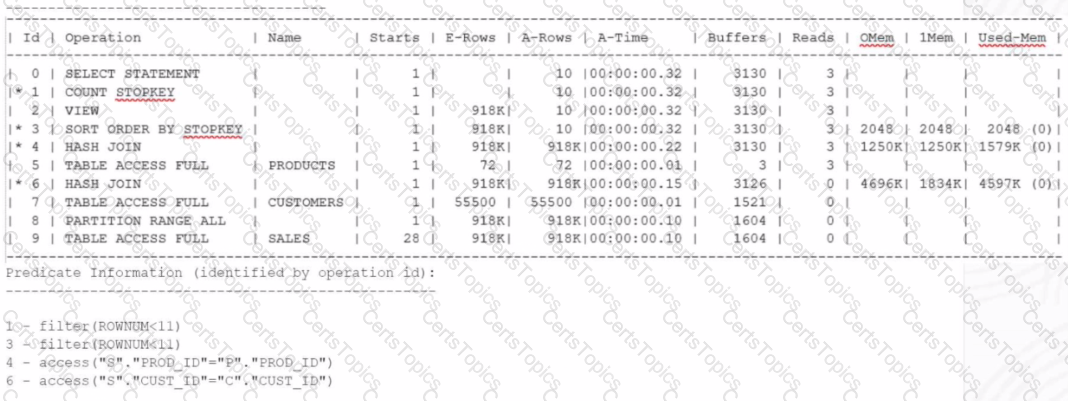Which two actions can cause invalidation or loss of one or more results in the SQL Query Result Cache?
Examine this statement and output:

Which three statements are true?
Which Optimizer component helps decide whether to use a nested loop join or a hash join in an adaptive execution plan?
What is the right time to stop tuning an Oracle database?
Which two types of performance problems are reported by ADDM for PDBS?
You must write a statement that returns the ten most recent sales. Examine this statement:

Users complain that the query executes too slowly. Examine the statement's current execution plan:

What must you do to reduce the execution time and why?
A Standard Edition production database has performance problems for two hours on the same day each week.
Which tool must you use to diagnose the problem?
A database supporting a mixed workload is hosted on a server with 64 CPUs.
A large number of free buffer waits and buffer busy waits occur affecting performance.
The buffer cache size was then increased but after a few hours, the same wait events occur more often than before the change.
Examine these parameter settings:

Which two actions can help reduce the number of these waits7
Which two statements are true about cursor sharing?
Which three types of statistics are captured by statspack with snap level 6?
Examine this code block, which executes successfully:
DBMS_SERVER_ALERT. SET_THRESHOLD (
DBMS_SERVER_ALERT.CPU_TIME_PER_CALL, DBMS_SERVER_ALERT. OPERATOR_GE, '8000',
DBMS_SERVER_ALERT.OPERATOR_GE, '10000', 1, 2, 'inst1',
DBMS_SERVER_ALERT.OBJECT_TYPE_SERVICE, 'main.regress.rdbms.dev.us.example.com') ;

What will happen?
Examine this AWRreport excerpt:

You must reduce the impact of database I/O, without increasing buffer cache size and without modifying the SQL statements.
Which compression option satisfies this requirement?
Multiple sessions are inserting data concurrently into a table that has an LOB column.
At some point in time, one of the sessions cannot find available space in the LOB segment and needs to allocate a new extent.
Which wait event will be raised in the other sessions that need space in the LOB column?
You use SQL Tuning Advisor to tune a given SQL statement.
The analysis eventually results in the implementation of a SQL Profile.
You then generate the new SQL Profile plan and enforce it using a SQL PlanBaselinebut forget to disable the SQLProfile and a few days later you find out that the SQL Profile is generating a new execution plan.
Which two statements are true?
Which two statements are true about space usage in temporary tablespaces?
Which three statements are true about server-generated alerts?